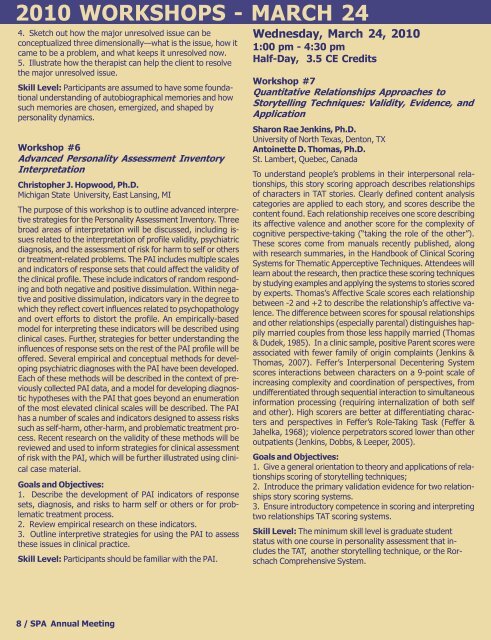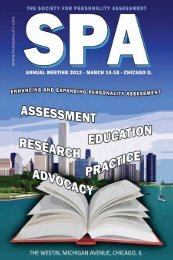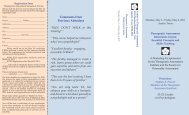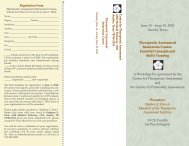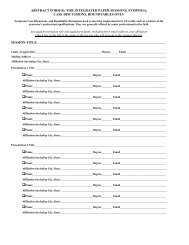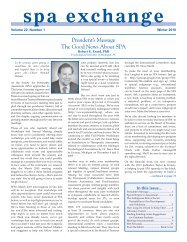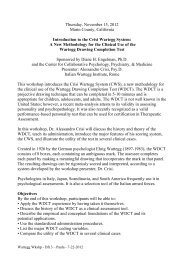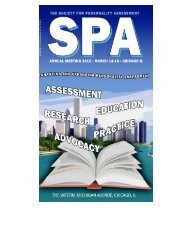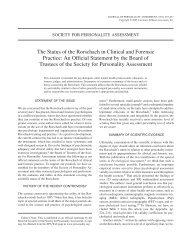From Routledge Journals - Society for Personality Assessment
From Routledge Journals - Society for Personality Assessment
From Routledge Journals - Society for Personality Assessment
Create successful ePaper yourself
Turn your PDF publications into a flip-book with our unique Google optimized e-Paper software.
2010 WORKSHOPS - MARCH 244. Sketch out how the major unresolved issue can beconceptualized three dimensionally—what is the issue, how itcame to be a problem, and what keeps it unresolved now.5. Illustrate how the therapist can help the client to resolvethe major unresolved issue.Skill Level: Participants are assumed to have some foundationalunderstanding of autobiographical memories and howsuch memories are chosen, emergized, and shaped bypersonality dynamics.Workshop #6Advanced <strong>Personality</strong> <strong>Assessment</strong> InventoryInterpretationChristopher J. Hopwood, Ph.D.Michigan State University, East Lansing, MIThe purpose of this workshop is to outline advanced interpretivestrategies <strong>for</strong> the <strong>Personality</strong> <strong>Assessment</strong> Inventory. Threebroad areas of interpretation will be discussed, including issuesrelated to the interpretation of profile validity, psychiatricdiagnosis, and the assessment of risk <strong>for</strong> harm to self or othersor treatment-related problems. The PAI includes multiple scalesand indicators of response sets that could affect the validity ofthe clinical profile. These include indicators of random respondingand both negative and positive dissimulation. Within negativeand positive dissimulation, indicators vary in the degree towhich they reflect covert influences related to psychopathologyand overt ef<strong>for</strong>ts to distort the profile. An empirically-basedmodel <strong>for</strong> interpreting these indicators will be described usingclinical cases. Further, strategies <strong>for</strong> better understanding theinfluences of response sets on the rest of the PAI profile will beoffered. Several empirical and conceptual methods <strong>for</strong> developingpsychiatric diagnoses with the PAI have been developed.Each of these methods will be described in the context of previouslycollected PAI data, and a model <strong>for</strong> developing diagnostichypotheses with the PAI that goes beyond an enumerationof the most elevated clinical scales will be described. The PAIhas a number of scales and indicators designed to assess riskssuch as self-harm, other-harm, and problematic treatment process.Recent research on the validity of these methods will bereviewed and used to in<strong>for</strong>m strategies <strong>for</strong> clinical assessmentof risk with the PAI, which will be further illustrated using clinicalcase material.Goals and Objectives:1. Describe the development of PAI indicators of responsesets, diagnosis, and risks to harm self or others or <strong>for</strong> problematictreatment process.2. Review empirical research on these indicators.3. Outline interpretive strategies <strong>for</strong> using the PAI to assessthese issues in clinical practice.Skill Level: Participants should be familiar with the PAI.Wednesday, March 24, 20101:00 pm - 4:30 pmHalf-Day, 3.5 CE CreditsWorkshop #7Quantitative Relationships Approaches toStorytelling Techniques: Validity, Evidence, andApplicationSharon Rae Jenkins, Ph.D.University of North Texas, Denton, TXAntoinette D. Thomas, Ph.D.St. Lambert, Quebec, CanadaTo understand people’s problems in their interpersonal relationships,this story scoring approach describes relationshipsof characters in TAT stories. Clearly defined content analysiscategories are applied to each story, and scores describe thecontent found. Each relationship receives one score describingits affective valence and another score <strong>for</strong> the complexity ofcognitive perspective-taking (“taking the role of the other”).These scores come from manuals recently published, alongwith research summaries, in the Handbook of Clinical ScoringSystems <strong>for</strong> Thematic Apperceptive Techniques. Attendees willlearn about the research, then practice these scoring techniquesby studying examples and applying the systems to stories scoredby experts. Thomas’s Affective Scale scores each relationshipbetween -2 and +2 to describe the relationship’s affective valence.The difference between scores <strong>for</strong> spousal relationshipsand other relationships (especially parental) distinguishes happilymarried couples from those less happily married (Thomas& Dudek, 1985). In a clinic sample, positive Parent scores wereassociated with fewer family of origin complaints (Jenkins &Thomas, 2007). Feffer’s Interpersonal Decentering Systemscores interactions between characters on a 9-point scale ofincreasing complexity and coordination of perspectives, fromundifferentiated through sequential interaction to simultaneousin<strong>for</strong>mation processing (requiring internalization of both selfand other). High scorers are better at differentiating charactersand perspectives in Feffer’s Role-Taking Task (Feffer &Jahelka, 1968); violence perpetrators scored lower than otheroutpatients (Jenkins, Dobbs, & Leeper, 2005).Goals and Objectives:1. Give a general orientation to theory and applications of relationshipsscoring of storytelling techniques;2. Introduce the primary validation evidence <strong>for</strong> two relationshipsstory scoring systems.3. Ensure introductory competence in scoring and interpretingtwo relationships TAT scoring systems.Skill Level: The minimum skill level is graduate studentstatus with one course in personality assessment that includesthe TAT, another storytelling technique, or the RorschachComprehensive System.8 / SPA Annual Meeting


